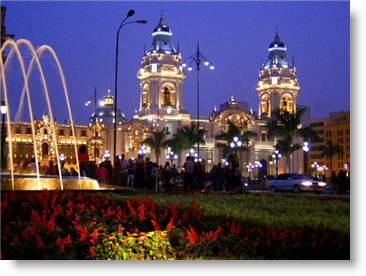 Lima kicked off a series of events on Friday to begin celebrating the city’s 479th anniversary and its designation as Plaza Mayor or main square of Spanish American Culture 2014, granted by the Madrid-based Union of Ibero-American Capital Cities, UCCI.
Lima kicked off a series of events on Friday to begin celebrating the city’s 479th anniversary and its designation as Plaza Mayor or main square of Spanish American Culture 2014, granted by the Madrid-based Union of Ibero-American Capital Cities, UCCI.
A live concert began on Friday afternoon in the city’s main square, with performances by many of the city’s leading musicians and dancers, to ring in the anniversary at midnight with the city mayor, Susana Villaran. On hand to present the Ibero-American award just before midnight was UCCI manager Fernando Rocafull.
Activities open to the public will be carried through the weekend in the city’s parks and squares, museums and galleries, to be continued throughout the year with 400 events that include concerts, theatre, exhibitions and community events.
Lima was founded on January 18, 1535 by Francisco Pizarro, taking over a fertile valley of farms and a population of some 150,000 inhabitants governed by Taulichusco. Today, Peru’s capital has a population of close to nine million — more than a third of the country’s population — spread out in 49 districts.
Taulichusco, once relegated to obscure historic documents, is now honored in the city’s Plaza Mayor with a large granite rock on the Pasaje Santa Rosa, while a statue of Francisco Pizarro — by American sculptor Charles Rumsey — that once stood on the steps in front of the city’s cathedral, was then moved to a side square and has now been removed to a small park behind the government palace and San Francisco church.
The Plaza Mayor culture award granted by the UCCI —San Juan in Puerto Rico won the Culture Capital award for this year — was granted on the basis of three culture projects presented by the Lima municipal government and which are now in operation, including the Community Live Culture Program, to encourage theatre and dance, and the recovery and restoration of pre-Columbian and archaeological spaces.
Overseeing the entire program is Pedro Pablo Alayza, the city’s cultural manager, who has worked to ensure there will be activities throughout the 12 months of 2014, a total of 400 events.
“We want this city to be seen everywhere in the world, and even more importantly, that the citizens of Lima feel pride in their city,” Alayza said.
Since Mayor Villaran’s election in 2011, several of the city’s cultural activities have been restored, including the re-opening of the Pancho Fierro gallery in the town hall building, after being abandoned for eight years, as well as the Lima Photography Biennial, to be held in April, and the Festival of the Performing Arts (November), which during the 1990s attracted troupes and performers from all over the world.
Meanwhile, progress is also being made in the city’s still chaotic public transport system. Gustavo Guerra, president of Protransporte, announced this week that the city has been able to award 36 of 49 bids for routes along five traffic corridors. The bids have been awarded to companies with a minimum of 600 bus units for 10-year concessions, discarding the previous system of dozens of small companies, many with fewer than 40 units, for short-term contracts, a system that inevitably led to corruption and chaotic competition for passengers.
“I think these [concessions] now make the transport reform irreversible, “Guerra said, explaining that the bid winners have been assigned certain rights in the contracts.





